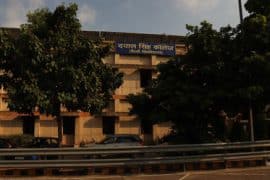Even though, I’m stuck some thousands of miles away pegging away on abstract Economic concepts, writing on Asmat and the village we’ve been working in is somehow easy and the memory is lucid and detailed. That’s not surprising. Working in the village of Soda in Rajasthan is the most important thing I’ve done, and it motivated my Masters.
Lavanya Garg, the co-founder of Asmat, had a model of rural volunteering in her mind after teaching children in Cape Town, South Africa. She wanted to design an organization such that students from all over the country would volunteer as part of an ongoing program and cater to the needs of the village. Essentially, we wanted to design a programme for the development of the village, and as a by-product sensitize urban young Indians about the problems facing rural India. I still remember when she had to call the village leader of Soda, Sarpanch Chavvi Rajawat (yields an interesting google search) in 2013. The nervousness we felt about calling someone who’d done the unthinkable – quit her well-paying corporate job to devote herself to working in her ancestral village was fairly justifiable.
Our journey after that phone call wherein she more than happily agreed to have us volunteer has been fascinating. Each volunteer has their story, possibly each villager has his/her story over the past two and a half years over the course of 6 volunteering programs. Each program had its own story. They do keep coming back at times least expected. The story about how Lavanya had to pretend she was a journalist when a small tussle broke out between villagers. Or how hard it was to not get angry when the boys didn’t understand they had to respect their female classmates and let them answer, but understand and explain calmly. Or just the village’s immense natural beauty – the fields, the reservoir as the sun sets, the chai in the cold winter mornings.
But coming back to our work, before I get lost in missing. I mentioned that our aim was to cater to the village’s needs. We started off with wanting to work on education that isn’t covered by school curricula. We’ve encapsulated more notions of non-academic education along the way, expanding the age group we cater to and the concepts we talk about. We’ve brought in sessions on awareness on government schemes, alcohol and tobacco – a rampant issue, health and hygiene. Additionally, something that is really close to our hearts, understanding the taboo that revolves around menstrual hygiene and ensuring that the girls adopt sanitary practices. It has been brilliant to hear of the adoption of sanitary pads by women in subsequent programs. We’ve covered all 10 hamlets of the village; we understand its breadth, the communities’ dreams and aspirations for their children. We also know better than to view it as one homogenous unit. In one of the many conversations while working, the Sarpanch recognized how we could not do away with even one element of our work. Only the combination of all these, recognizing different needs will lead to holistic change.
At this point in Asmat’s career, two and a half years into inception, two and a half years remaining on our (Soviet-like) 5 year plan, it’s a good time to look back and understand what we want to keep going and how. Since hindsight favours you with wisdom, Asmat will be streamlining its activities down to maximize their impact. Now is the time to spread our wings a little wider, go into our projects and particular sessions a bit deeper. In order to attain the depth and maximal impact, we require urgent cash-flow to our organisation. We hope to raise Rupees 80,000. A small sum for many NGOs, a big sum for one village and the possibilities. The next paragraph details the usage, that injection of funds will allow which I hope will make you consider donating.
This winter, we’re looking at a two-day health camp, a necessity for many since the nearest hospital is far. The camp will cost 40,000 in order to pay the doctors’ honorarium and their stay in the village, as well as costs of setting up and getting much needed medicines to the village. Why do we think the village needs this? In the second program, we conducted a survey on the effectiveness of public pension schemes in the village. The pensioners struggles were immeasurably hard, and we tried to bring down their stories in a line in our little survey pads. The lack of a good hospital nearby stood out, since they spent a substantial portion of their pensions just getting to the nearest hospital. Apart from diseases that afflict the elderly, tuberculosis and kwashiorkor are pertinent problems as well that we hope to address.
We’re looking at books and videos, teaching materials for the children to sensitize them on issues such as good touch bad touch. It’s hard to get their attention but more importantly hard to find ways of making them understand how they can and should resist issues which they are not used to discussing in rural India. We’re looking to train women on banking and bookkeeping , not just in order to ensure that the women can start their own business but also to be able to save a little more for their girl children. Books, personalised for the village, projectors, stationery and equipment for holding sessions will cost around 10,000 rupees. One of our greatest losses has been the number of volunteers we’ve lost because traveling to Soda turns out more expensive. With Rupees 10,000, we can ensure brilliant volunteers are subsidised. Some of our work, such as using cotton to make simple biodegradable pads, was thought of by creative volunteers,which we hope to take forward and turn into a bigger thing.
Our fundraising is not just tied to one exact goal. For a meagre sum of Rs. 2500, this winter, we will be able to educate 30 women in Soda about government health schemes that they can avail of, sensitize 10 adolescents about the ill effects of substance abuse and make 20 women financially literate. The value added through this money, which is probably the cost of your next pair of jeans, will be much greater than the sum of its parts, as the positive effects will only multiply.
Kavya Saxena
Co-founder, Asmat





Comments are closed.